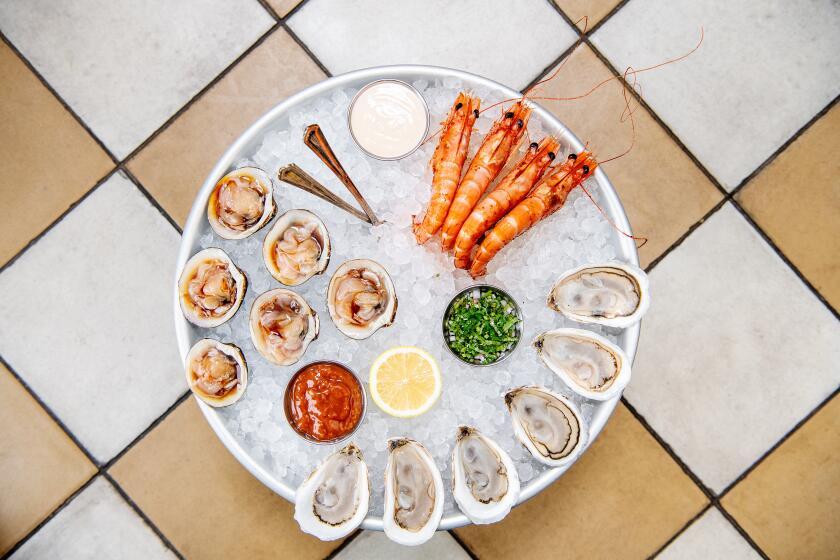
- Share via
- Ari Kolender, the chef behind Found Oyster and Queen St., has a new cookbook: “How to Cook the Finest Things in the Sea.”
- Try three easy recipes from his book. You’ll be making scallop tostadas and mackerel tartare all summer long.
Ari Kolender, chef and co-owner of two of L.A.’s most popular seafood restaurants, didn’t grow up in a household that cooked a lot of fish or shellfish because his grandfather kept kosher. But in high school he crabbed from friends’ dinghies and worked at a storied restaurant called Hyman’s on Market Street in Charleston, S.C., just blocks from the estuary-harbor where the city’s three rivers converge — and where his love of seafood began.
The best cookbooks of the 2025 spring season help cooks get comfortable in the kitchen.
He watched the deliveries arrive at 7 in the morning and the owner of the restaurant hop on the back of the truck and sort through fish to decide which to buy. “Seeing the whole process from being on the water and people catching fish to the finished product, I just loved the level of care being taken, the idea of that,” he says.
By the time he opened Found Oyster in L.A. in 2019, he’d shucked countless bivalves; worked at seafood temple Providence in Hollywood; and helped open Leon’s Oyster Shop and run the raw bar at the Ordinary in Charleston, a brasserie celebrating the bounty of the coastal Carolinas.

In tiny Found Oyster, with a closet-size kitchen, Kolender created the consummate L.A. clam shack: Chill cross-coastal vibes meet platters of pitch-perfect seafood, all rigorously sourced. He estimates that in the five years since Found debuted, the restaurant has sold nearly 1 million oysters, several thousand a week. (“We’ve gotta throw a party,” he notes.)
When it comes to cooking seafood, Kolender’s motto is: “Messing with it messes with it.” Do less — less handling, less fussing, less worrying about how delicate or weird or finicky seafood might or might not be.
That’s the thrust of his just-published cookbook, “How to Cook the Finest Things in the Sea,” co-written with Noah Galuten. “The thing I hope people will take away from this,” Kolender says, “is to leave their assumptions [about] cooking seafood behind and trust that you can do it; you have the ability, you have everything in front of you that you need.”


They take just a few minutes to make: diver scallops broiled with Espelette butter at Queen St. Framed photos and illustrations line one of the walls at the restaurant, a nod to the Carolina coast, where seafood abounds.
“Seafood tastes best when it is handled very little,” he writes in the book’s introduction. “I don’t mean that in terms of adding flavor, but literally putting your hands on the product. ... The less you touch it, the more beautiful it’s going to be and the more put-together it’s going to look.”
You can make broiled scallops with Espelette butter in less time than it takes to answer an email. A tangy tartare folded with crème fraîche and herbs is one of the most delicious (and easiest) ways to use mackerel (or yellowtail or Arctic char or ocean trout, if you like).


Bottles of Crystal hot sauce line a counter at Queen St. Recipes from the book, clockwise from top: swordfish cavatappi; mackerel tartare; and broiled scallops with espelette butter.
Kolender’s expertise is pristine seafood served in an unpretentious way with references to the Lowcountry — specifically the marshy, riverine Ashepoo-Combahee-Edisto (or ACE) Basin rich with oysters and mussels — along with flavors creatively his own.
People line up in front of Found (which now takes reservations), waiting for oysters and chicken-fried yellowtail collars, crab and trout dips, grilled head-on prawns and raw-scallop-yuzu tostadas. The horseshoe-shaped bar at his second restaurant, Queen St. Raw Bar & Grill in Eagle Rock, is one of L.A.’s best spots for languid oyster-eating (and vermouth-sipping) too.
Eating seafood sustainably is simpler than you think. Eat less salmon, tuna and shrimp and more of other kinds of fish and shellfish, for starters.
Kolender’s standing behind the Queen St. bar on a recent Tuesday, mixing cubed Spanish mackerel, line-caught off the coast of North Carolina, with diced cucumbers, cornichons, capers and herbs — a small sloping mound of tartare. He says the sweetness and “funkiness” (and by funky he means umami) and fattiness of the fish stand up to the fresh and pickled vegetables and the lactic acid of crème fraîche (his is spiked with wasabi oil) and citric acid of lemon juice. “They interact on the palate in a way which is just creating flavors,” he says.


Big flavors — capers, pickles, cucumbers, horseradish, crème fraîche, lemon, dill and parsley — amp up this mackerel tartare.
And then he showers the tartare with more herbs — a handful of dill, parsley and chives. “It’s something I’m really big on, it’s the use of herbs in general. I usually tell people, especially people we’ve just hired who aren’t really used to how we cook, ‘It doesn’t matter if you’re out here making crudo or in the kitchen making pasta, you can’t use too much.’”
At Queen St., named after a historic utopia-planned road that runs through the French Quarter in Charleston, the mackerel tartare is a mainstay on the menu, which is a study in the diversity of fish: oysters, anchovies, yellowfin tuna, shrimp, Jonah crab, brook trout from a farmer in Maine who catches them with his bare hands.
Bill Addison reviews seafood bar Found Oyster in East Hollywood.
Kolender opens the door to the walk-in refrigerator, where shelves are stacked with tubs of the day’s Mere Point oysters. A 25-pound halibut procured from fisherwoman and uni diver Stephanie Mutz in Santa Barbara will become a fish-and-chips special; fish baked in paper with fennel, leeks and olives; and crudo with ginger and blood orange.
In the kitchen, Kolender arranges smooth, chubby scallops, each smaller than a golf ball (“schmedium” he calls them), on an eighth-sheet pan lined with special fish-drying paper. “I like the amount of time it takes to cook these in the pan,” he says. “It’s the right ratio of exterior sear to the middle being medium rare.
“The easy principle to remember is starting with something dry, not having a wet surface. The other trick is not seasoning them until you’re just about to put them in the pan. The second you add salt to the scallop it’s going to start releasing its water.”

The scallops sizzle in a hot carbon-steel skillet on the stove, and Kolender transfers the pan to the high-heat broiler. After a minute he adds Espelette butter and returns it to the broiler. Thirty seconds later, as soon as the butter is frothy, it’s done. The whole process takes less than four minutes.
“The recipe is the pan,” he says. “You could dump this onto a platter or you could eat it directly out of the pan.” Tear hunks from a crusty loaf of bread and dunk them into the chile-tinged butter.
Summer will bring bay scallops still in their shells, along with soft-shell crabs. “It’s a very special thing. Back home soft-shell crabs are literally on the roadside at shacks that sell seafood. I just really love it.
“Things that I love is where I start, and hopefully people like it too.”
Ari Kolender will be signing copies of “How to Cook the Finest Things in the Sea” at the L.A. Times Food x Now Serving booth at the Festival of Books on Saturday, April 26, 11 a.m. to noon.
Get the recipes
How to Perfectly Broil Scallops With Espelette Butter
(You Will Love This) Mackerel Tartare With Horseradish and Dill
Found Oyster's Scallop Tostadas with Yuzu-Apple Vinaigrette

More to Read
Eat your way across L.A.
Get our weekly Tasting Notes newsletter for reviews, news and more.
You may occasionally receive promotional content from the Los Angeles Times.


















